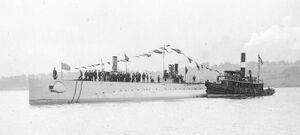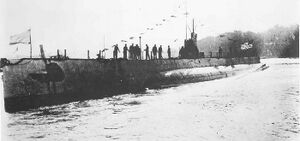T-class: Difference between revisions
Pbcjohnston (talk | contribs) mNo edit summary |
Pbcjohnston (talk | contribs) Added photos |
||
| Line 25: | Line 25: | ||
=== <big>AA-2/T-2 (SF-2)</big> === | === <big>AA-2/T-2 (SF-2)</big> === | ||
[[File:T-2 launch.jpg|left|thumb|U.S. Navy photo]] | |||
<div style="text-align: justify;"><span style="color:#00008B"> | <div style="text-align: justify;"><span style="color:#00008B">AA-2 in the Weymouth Fore River just after her launch on September 6, 1919. She would be renamed T-2 just over one year later, before she was commissioned.</span> | ||
[[T-2|See More T-2 photos]] | [[T-2|See More T-2 photos]] | ||
| Line 33: | Line 33: | ||
=== <big>AA-3/T-3 (SF-3)</big> === | === <big>AA-3/T-3 (SF-3)</big> === | ||
<div style="text-align: justify;"><span style="color:#00008B"> | |||
[[File:T-3 trials.jpg|left|thumb|]] | |||
<div style="text-align: justify;"><span style="color:#00008B">T-3 running trials, late fall, 1920. Note that the bridge fairwater has not yet been installed, a common practice for the Fore River Shipbuilding Company at the time.</span> | |||
[[T-3|See More T-3 photos]] | [[T-3|See More T-3 photos]] | ||
Revision as of 15:59, 11 July 2023
Design, Construction, and Naming Notes
The USN's first attempt at building a fleet boat was the T-class of 1916 and 1917. Electric Boat got the contract for three boats, and they would be built at their sub-contractor Fore River Shipbuilding in Quincy, MA. EB took the double hull form of the previous USS M-1 (Submarine No. 47) and scaled it up. It was felt that only a double hull boat would have the fuel bunkerage capacity to achieve the desired range. It was well understood that no diesel engine in existence was powerful enough to push the boat at the surface speeds the fleet boat requirement called for, so EB made the fateful decision to put two engines on each shaft, with the engines connected in tandem via a clutch at the crankshaft. While a seemingly good idea at first, the tandem arrangement proved to be a complete failure. The boats were only able to make their designed speeds for short periods of time, and the engines were utterly unreliable.
The FY-16 boat, when laid down, was called Schley, in honor of the Spanish-American War Commodore Winfield Scott Schley. Realizing that this name was way out of the norm for submarines, less than a year later, before being launched, her name was changed to AA-1. The unusual double letter in the name was supposedly to differentiate it as a fleet submarine, separate from the harbor and coastal defense boats. After only nine months in commission, the name was changed to T-1. The two sister boats authorized in FY-17 were originally named AA-2 and AA-3, and were renamed T-2 and T-3 on September 22, 1920, the same day as AA-1/T-1. All three boats were given designations in the SF series, and although they survived long enough to have their designations changed with the other submarines, none of the three were ever redesignated in the SS series.
These boats were nearly complete failures, and were roundly disliked by their crews and the Navy for reasons spelled out in the article at this link. T-1 only served three years, T-2 was pulled from service after only 1½ years. T-3 was laid up in reserve for a while, then was pulled out and recommissioned to serve as a test bed for a new BuEng/MAN engine. When the test program was complete T-3 was promptly discarded.
The fleet submarine concept was a good one for the USN, but it would require another 10 years of technological development and refinement to become a reality.Schley/AA-1/T-1 (SF-1)

AA-2/T-2 (SF-2)

AA-3/T-3 (SF-3)

Page created by:
Ric Hedman & David Johnston
1999 - 2023 - PigBoats.COM©
Mountlake Terrace, WA, Norfolk, VA
webmaster at pigboats dot com
